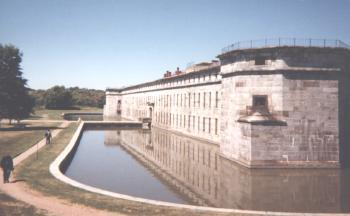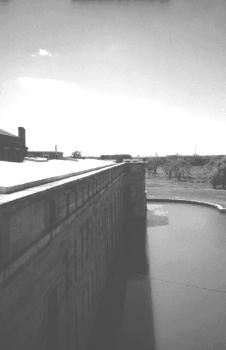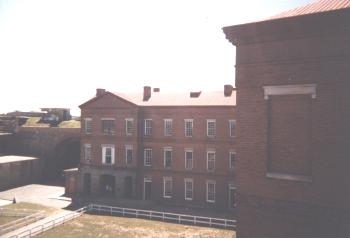Pea Patch Island, New Castle Co., Delaware (July 2000)

The newly-minted United States government identified the need for a fort along the Delaware River. This would help protect the approaches to major port cities such as Wilmington, Delaware and Philadelphia, Pennsylvania. The military eyed Pea Patch Island, a swampy swath of river deposit that barely rose above the waves (map). It sat at a strategic point mid-river and could serve as an ideal choke point for enemy ships that might attempt to traverse this stretch within its easy cannon fire.
The government claimed the island by eminent domain in 1813 while war still raged with Great Britain. Invasion was no idle threat, and in fact many buildings in Washington, DC were burned later in the war and a thwarted attack on Baltimore served as the inspiration for Star-Spangled Banner. Enemy forces never made it up as far as Pea Patch Island during the War of 1812 but the possibilities weighed heavily on the minds of military commanders. They began building a defensive fortification here in the waning days of the conflict.
A fire broke out on the nascent fort in 1831 and destroyed much of it. A new fort, the present structure, replaced the earlier effort then in ruins. Construction took place between 1848 and 1859; one of the largest fortifications of its kind in the nation. The timing prove fortuitous: this state-of-the-art structure became fully functional in the years immediately before the outbreak of the Civil War.
Civil War Prison

Fort Delaware garnered significant controversy during the Civil War. It served as a prisoner of war camp for captured Confederate soldiers, holding them for years in harsh conditions. Marshland formed most of Pea Patch Island. That’s not readily apparent today because several feet of river mud dredged from the river was placed here during the early Twentieth Century. During the war, however, the fort stood within a fetid swamp.
Horrible Conditions
The fort could handle the initial prisoners but hardships multiplied when captured soldiers arrived by the thousand after the Battle of Gettysburg. They suffered through sweltering summers and harsh winters with little protection from the elements. Fort Delaware couldn’t function as a prison and Pea Patch island became hideously overpopulated. Men housed in hastily-constructed prison barracks suffered in unsanitary tightly-packed conditions and traded infectious disease among themselves.
More than 12,000 prisoners lived here at a time, and more than 30,000 cycled through Fort Delaware by the time hostilities ended. Some lucky soles managed to escape, a fairly common event. Perhaps several hundred managed to make it to the shore even though they had to swim half way across the river. Others fared much more poorly and nearly 3,000 of these prisoners never made it off Pea Patch Island alive. They could not be buried on this waterlogged swamp and they found their final resting place across the river at Finn’s Point National Cemetery in New Jersey.
Into the 20th and 21st Centuries

The history of Fort Delaware didn’t end with the Civil War, and in fact the fortress continued to serve the defensive needs of the nation all the way through the Second World War before the army declared it surplus property in 1947. While masonry structures such as this became largely obsolete even by the end of the Civil War with the advent of the rifle-bored cannon, many of them went through the necessary retrofits for subsequent conflicts. Fort Delaware followed the same pattern.
The fort became a nexus for the coordination and laying of minefields along the river during the Spanish-American War and again in the First World War. Even this purpose became obsolescent after airborne military tactics made it possible to attack cities while ignoring the rivers. Fort Delaware no longer served a useful function.
After the Wars
Ownership of the 288 acre island transferred to the State of Delaware. The state turned it into a public park and living history museum. The primary focus rests squarely in the Civil War era, the Summer of 1864. Visitors can see recreated soldiers and workers going about their lives as if living in the Nineteenth Century. Troops drill, cannons fire, blacksmiths bang anvils, and everyday tasks follow patterns from a bygone era.
Visitors also have an opportunity to venture down several walking trails along the grounds for better views of the fort or to get closer to nature. Wildlife flourishes on Pea Patch Island, a rural oasis in the middle of the intensively populated northeastern corridor of the United States. Here, birders in particular have a great opportunity to spot colonies of herons, ibises and egrets that flock to the river in the summer months in great numbers. Birds can nest in isolation, an increasingly rare opportunity around here. Visitors can also find open space for picnics or relaxing after walking around the extensive fortifications if not interested in the birds.
No roads extend to Pea Patch Island. No private watercraft are allowed to dock here, either. Ferries take visitors from the Delaware and New Jersey sides of the river. Upon landing, visitors ride in a truck up to the fortress.
Readers who have an interest in forts might also want to check my Forts, Fortresses and Fortifications page.

Leave a Reply